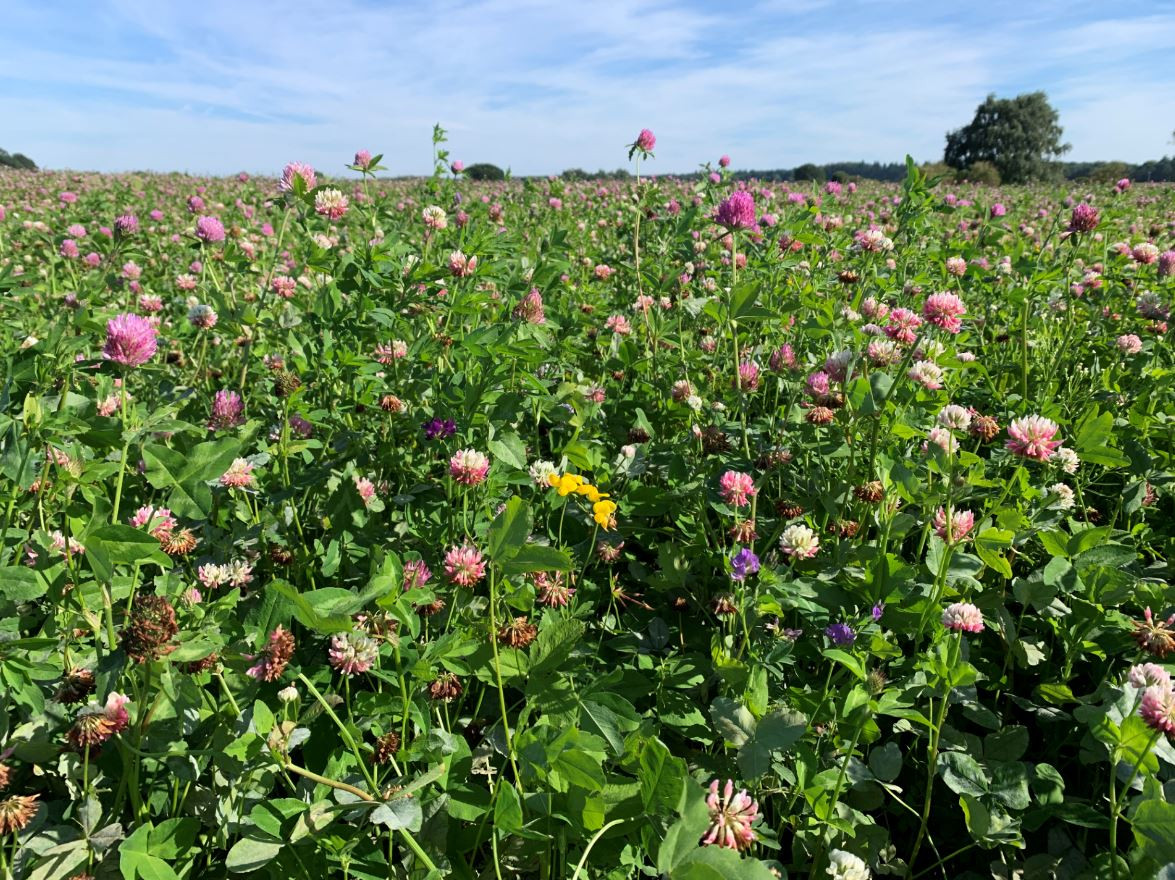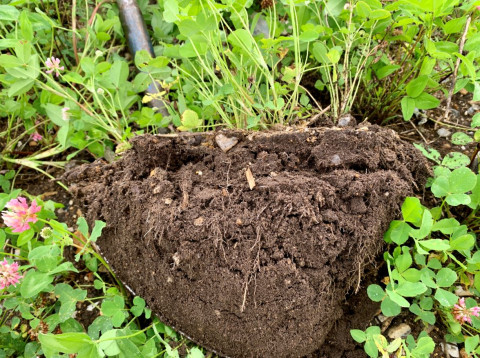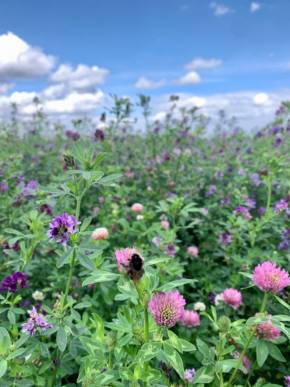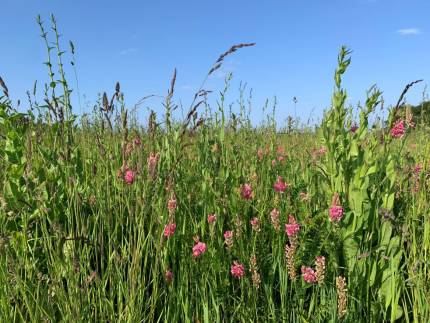Managing your soils this season
There are a number of topics this blog could cover: the weather, inputs, grain prices, environmental options… the list goes on. But, as we make our way through this spring, I think it's worth acknowledging the continuously changing agricultural landscape and some of the routes for navigating it. I think we'd all agree that in our industry it often feels different from one day to the next, with new opportunities and challenges abound all while we're simultaneously trying to digest the latest updates.
The one element in farming that is firmly placed and will never change is the value of our soils. Soil is the fundamental element that allows agriculture to exist, it quite literally is the foundation for all of farming's building blocks and the very thing that facilitates the food on our tables - yet often it can be overlooked.
Following the drought of 2022 and the prolonged wet winter of 2023, soils are likely purged of nutrients and their aerobic qualities will have been affected. Therefore, getting soil back to a good condition will be a top priority.
Using technology to assess soil
A good first point of call is knowing the costs of production which will help you make informed decisions when it comes your soils. MyFarm Analytics, powered by Yagro, helps you benchmark crop production costs and holistically assess your own farm data. You can also use insights from the biomass imagery and yield data in MySOYL to gain an understanding of weaker performing areas on farm.
Secondly, you should sample for organic matter to get a baseline of your soil. SOYL can support you with this, then Kings can work with you to select crops that are best suited for your soil's needs.
You can gain further insights from SOYL's electro-conductivity scanning service. This accurately maps soil type variation across your farm which is a one-off investment, allowing you to better understand your soils. Once you gain this understanding, you could then consider introducing variable rate applications of seeds and inputs, optimising production and management even further.
What are the requirements of soils?
Once you know the conditions of your soil, it'll be time to consider it's needs.
This year, a reset won't be as simple as running a lump of steel through the ground when conditions allow. We need to sympathise with the needs of soil and understand what it requires.
Soil needs to function as a self-sustaining ecosystem. This means it needs the ability to access a feed source or nutrients while being able to breathe, drain and shelter from damaging conditions. These stresses could be prolonged by intense sun light, long or heavy periods of rain and unnecessary disturbance that all disrupt its biology and function.
The easiest way to give soil what it needs is by keeping a constant cycle of living roots in it and not exposing its surface for long periods of time, such as between crops or at high-risk times of the year.
Cropping should have a varied rotation and the inclusion of livestock when and wherever possible can deliver notable benefits. For example, the bacteria brought in by animals can do wonders for soil health, by increasing the levels of soil biota.
How to recondition soils – the role of the SFI
Driving across the country, it's easy to see that the crops that have survived the wet winter are still struggling and will need nursing back to health. Bare ground or failed areas will need to be reset and re-conditioned.
Reconditioning soil doesn't take long, but it will often require a change of approach which could be in the form of a Sustainable Farming Incentive (SFI) agreement.
In 2022, many growers were faced with higher costs of spring inputs followed by the drought. Then, in the face of falling grain markets and wet weather in 2023, we unsurprisingly saw increased interest in the SFI.
You're likely questioning what the SFI and other publicly funded schemes mean for farming and food production. Rest assured; we will always need UK-grown produce. However, now is the time to look at rotations and methods of production in tandem with environmental considerations; considering how something like a legume fallow could work as a beneficial crop - not just an additional payment option.
Making changes can be easier than you imagine and the SFI is specifically designed to help you do this. It focuses on soils, water and air quality - all of which farming can have a huge impact on.
Whatever you do, try not to leave what was waterlogged soil bare for the next five to seven months as it'll bleach if we have a drought. 'Bleaching' is the prolonged exposure of soil to sun light. Soil damage through exposure during the winter is often talked about, yet we hardly ever hear about the damaged caused in the longest daylight hours when intense and prolonged sunlight kills off the biology in the soil.
An analogy I like to use: Think of soil as skin and living plants as either sun cream or a wet suit!
Mixture considerations
Before I go into seed mix recommendations here, it's worth noting that our 2024 Environmental Land Management and Specialist Crop catalogue offers detailed information on all our seed mixes as well as our specialist products and services – including the support available with environmental land management.
1. Legumes
A summer catch/cover crop in place for ten plus weeks can invigorate spring soil before returning to normal proceedings in the autumn. Our Summer Legume Mix is ideal for this, providing the following benefits:
- It's a brassica-free mix so can be used ahead of oilseed rape
- Diverse rooting structure offers soil structure enhancement
- Reduces any potential soil erosion risk
- Produces a large, visually attractive crop canopy
- Provides essential pollen and nectar for pollinating insects in late summer.
Bringing a legume fallow into a rotation through funding in the NUM3: Legume fallow SFI action can offer an alternative break crop while also significantly improving your soil's health over a 12–24 month period.
Legumes gather atmospheric nitrogen and store it in nodules on their roots in the soil. This allows the plant to gather its own food source while locking up these nutrients. Brand new for 2024, our Annual Legume Fallow Mix is a great option to achieve these benefits while meeting SFI action requirements if that is your objective.
When brought back into a cereal crop, using legumes as a soil conditioning crop rather than a standard cash crop will produce a higher yielding and better-quality cash crop.
2. Herbal leys
For a longer-term option, a herbal ley is a great choice as it builds soil organic matter (OM) over three to five years and reduces weed burdens. A mix of herbs, legumes and grasses make a fantastic grazing crop and can forage well - our Elite Herb Rich Sward Mix ticks all these boxes.
Many species in a herbal ley are deep rooting and draw up nutrients and minerals from depths that can't be accessed by shallow rooting species. This benefits surface soil health and the leys last longer in dry conditions than standard grass leys.
A well-structured herbal ley will usually enter peak performance in years three to four, they become tired in the fifth year once the soil has improved which is the perfect time to bring the area back into cropping for a few years.
Funding for options like these do not only have to come through SFI or Countryside Stewardship (CS), the private sector is also heavily involved in financially rewarding actions that will benefit soil health.
Summary
Healthy soils inevitably result in a more reliable and productive business, able to provide a higher quality product that will be more resilient through extreme conditions.
Yes, things aren't ideal at the moment but a quote I once heard has never been more relevant than in agriculture today: "The best way to predict the future is to create it."
It's important to consistently review the situation you are in and take sound advice - you may discover opportunities that could be of great benefit to your farm business resilience and forward planning. The key action for now is to provide bare soils with a green cover or legume mix to support restructuring of the soil.
If you'd like more support with your cropping plans, please contact your Frontier, SOYL or Kings advisor. Alternatively, you can get in touch.
As a subscriber, you’ll receive email alerts each time a new blog is published so you can always stay updated with the latest advice and insights from our experts








Comments